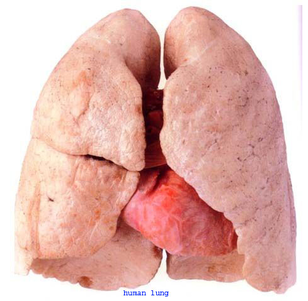
Description
Two cone shaped spongy organs of respiration. The right lung consists of three lobes while the left lung is slightly smaller consisting of only two lobes (the left lung has a "cardiac notch" allowing space for the heart within the chest).
The lungs contain approximately 2,400 kilometres (1,500mi) of airways and 300 to 500 million alveoli, having a total surface area of about 70 square metres (750 sq ft) (8,4 x 8,4m) in adults.
Each lung weighs 1.1 kilograms (2.4lb), therefore making the entire organ about 2.3 kilograms (5.1lb).
Function
The primary purpose is to bring air and blood into intimate contact so that oxygen can be added to the blood and carbon dioxide can be removed. This is achieved by two pumping systems, one moving gas and the other liquid. During a 24-hour period, the average human will breathe 23,040 times. Humans breathe 20 times per minute, more than 10 million times per year and about 700 million times in a lifetime.
The lungs convert angiotensin I to angiotensin II. In addition, they remove several blood-borne substances, e.g. PGE1, PGE2, PGF2α, leukotrienes, serotonin, bradykinin.
Colour
Dark red.
Shape
Like two long melons cut in half. The internal surface area is similar to a honeycomb and approximately the same size as a tennis court.
Location
In the chest.
Two cone shaped spongy organs of respiration. The right lung consists of three lobes while the left lung is slightly smaller consisting of only two lobes (the left lung has a "cardiac notch" allowing space for the heart within the chest).
The lungs contain approximately 2,400 kilometres (1,500mi) of airways and 300 to 500 million alveoli, having a total surface area of about 70 square metres (750 sq ft) (8,4 x 8,4m) in adults.
Each lung weighs 1.1 kilograms (2.4lb), therefore making the entire organ about 2.3 kilograms (5.1lb).
Function
The primary purpose is to bring air and blood into intimate contact so that oxygen can be added to the blood and carbon dioxide can be removed. This is achieved by two pumping systems, one moving gas and the other liquid. During a 24-hour period, the average human will breathe 23,040 times. Humans breathe 20 times per minute, more than 10 million times per year and about 700 million times in a lifetime.
The lungs convert angiotensin I to angiotensin II. In addition, they remove several blood-borne substances, e.g. PGE1, PGE2, PGF2α, leukotrienes, serotonin, bradykinin.
Colour
Dark red.
Shape
Like two long melons cut in half. The internal surface area is similar to a honeycomb and approximately the same size as a tennis court.
Location
In the chest.
 RSS Feed
RSS Feed
